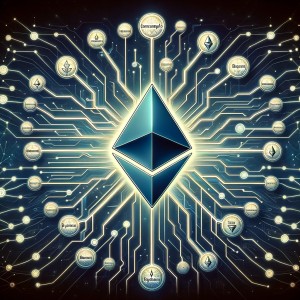The digital landscape is shifting thanks to the emergence of Non-Fungible Tokens (NFTs), unique digital assets offering verifiable ownership and rarity secured on blockchain technology. While initially gaining prominence through headline-making digital art sales, NFTs’ influence spreads across many domains, including real estate, media, and brand promotion.
Today, companies from various sectors, be they esteemed fashion labels, renowned global media houses, automotive behemoths, or ubiquitous food chains, are all dipping their toes into the NFT realm. Their ventures range from issuing rare virtual collectibles to tying digital tokens to physical purchases, indicative of the broad utility of this innovation.
The Appeal of NFTs for Big Brands
NFTs possess inherent characteristics—authenticity, scarcity, and indisputable proof of ownership—that redefine digital proprietorship and present lucrative opportunities for innovative brand strategies. Understanding these unique properties is crucial in exploring why many big brands are venturing into the NFT domain.
Innovative Marketing: In a crowded marketing space, NFTs offer brands a breakthrough method of standing out. By creating unique, collectible digital items, brands can generate buzz and engage with their customers in a way that wasn’t possible before. This form of marketing creates an emotional connection with customers, as they aren’t just purchasing a product but a unique piece of the brand’s history or art.
Enhanced Customer Engagement: NFTs provide a new avenue for customer interaction. Brands can use NFTs to offer their customers exclusive content, experiences, or perks, fostering a more engaged and loyal consumer base. This exclusivity and interactivity deepen the relationship between the brand and the consumer, creating a community of enthusiasts who feel directly connected to the brand.
New Revenue Opportunities: Beyond the initial sale of goods or services, NFTs open up additional revenue streams. Brands can earn royalties on the secondary sales of NFTs, ensuring they benefit from continued trading. Furthermore, by venturing into the digital goods marketplace, brands can tap into a customer base willing to pay premium prices for exclusive digital content.
The appeal of NFTs for big brands lies in the fusion of their unique properties with strategic applications. By embracing NFTs, companies are not just adopting a current trend; they are opening doors to a future where digital interaction, commerce, and collectible culture merge into a new realm of opportunity. The brands that recognize and leverage these digital tokens can enhance customer loyalty, differentiate themselves in a competitive market, and unlock new avenues for revenue, setting the stage for the next digital revolution in branding.
Case Studies of Brands Using NFTs
The exploration of NFTs by prominent brands across various sectors underscores the diverse applications of this technology. Here are specific instances of how some notable brands have integrated NFTs into their business models, marketing strategies, and customer engagement initiatives.
Coca-Cola
Coca-Cola embraced the NFT trend by launching commemorative digital collectibles in collaboration with Tafi, marking International Friendship Day. These NFTs, available on the Polygon blockchain, underline the company’s commitment to innovation and social responsibility, with proceeds benefiting charitable causes like the Special Olympics. This initiative highlights how brands can employ NFTs for social good while engaging their consumer base in new, meaningful ways.
Visa
Visa has ventured into the NFT space with its Visa Creator Program. This initiative aims to integrate artists, designers, and other creative professionals into the digital economy, providing a platform to monetize their work through NFTs. By supporting small businesses and individual creators, Visa demonstrates the potential for NFTs to democratize economic participation and innovation.
Lamborghini
Lamborghini’s foray into NFTs, through its “Epic Road Trip” program, created a buzz by offering digital collectibles in collaboration with NFT PRO and INVNT.ATOM. This strategic move promotes the brand’s exclusive luxury identity and connects with a new demographic of digital enthusiasts and collectors, expanding its market reach.
Nike
With its CryptoKicks Dunk Genesis, Nike pioneered a unique blend of fashion and digital ownership. Customers who purchase these NFTs can personalize their digital sneakers, emphasizing user engagement and a novel form of brand interaction. This innovative approach signifies a new era where fashion, digital art, and collectibles intersect.
Prada
Prada has taken a unique approach by offering complimentary NFTs with the purchase of physical items from their collection. By doing so, Prada is enhancing the exclusivity and value of owning their products while also making a pioneering step towards a new luxury shopping experience that bridges the physical and digital worlds.
TIME Magazine
TIME Magazine made a significant impact in the digital art space by releasing unique NFTs and building a community around digital collectibles. With over 150 artists and thousands of collectors involved since its inception, TIME has demonstrated the power of NFTs to foster communities and support creative expression.
Air Europa
In a groundbreaking initiative, Air Europa, in collaboration with TravelX and Algorand, introduced the world’s first NFT-based travel ticket series. This innovative approach has set a new precedent in the travel industry, showcasing the potential for NFTs to revolutionize ticketing and customer engagement.
Associated Press
The Associated Press’s venture into NFTs brought forward crucial ethical discussions when they withdrew a proposed NFT featuring refugee imagery amidst public backlash. This instance highlights the essential considerations of sensitivity and ethical boundaries in adopting NFTs, especially in sectors like journalism.
Citroën
In an exciting collaboration with Riot Racers, Citroën ventured into the metaverse, allowing gamers to acquire licensed Citroën NFT cars for their collections. This initiative not only enhances the gaming experience but embeds Citroën within a thriving digital ecosystem, connecting with a new generation of consumers.
Dolce & Gabbana
Achieving a remarkable $6 million record in the fashion NFT space, Dolce & Gabbana auctioned a hybrid virtual/physical collection, pushing the boundaries of luxury fashion. Their venture, #DGFamily, created in partnership with UNXD, exemplifies an innovative approach to community building and brand interaction in the digital age.
Chicago Bulls
The Chicago Bulls captivated sports fans and collectors with the release of their Legacy Collection, celebrating their six World Championship rings. This strategy demonstrated an intelligent use of NFTs to honor sports history, offer exclusive collectibles, and provide unique experiences, deepening fan engagement and loyalty.
Forbes
Forbes introduced a whimsical concept with its Virtual NFT Billionaire, a character boasting an extensive imaginary portfolio. This creative endeavor highlights the potential for blending finance, storytelling, and digital art, offering a novel way for audiences to engage with wealth and investment concepts.
CNN
Through “Vault by CNN,” the news giant preserved significant moments in modern history as digital art, creating a new avenue for news consumption and collector engagement. Although not actively maintained, the collection remains a testament to the potential intersection of journalism and digital collectibles.
Burger King
Burger King’s “Keep It Real Meals” NFT campaign, executed with Sweet’s platform, became a masterstroke in marketing, combining physical purchases with digital rewards. This strategy tapped into the collector’s enthusiasm and the broad appeal of exclusive digital assets, enhancing customer experience.
Mango
Mango innovated with a wearable NFT that verified event attendance, merging the fashion retail experience with digital technology. This strategy marked a forward-thinking step in customer engagement, offering a unique interaction with the brand in the virtual world.
Meta
Exploring NFTs, social media titan Meta began testing Ethereum and Polygon-based tokens among select creators. This initiative underscores the company’s commitment to staying abreast of digital trends, fostering creator monetization, and integrating modern digital assets into social media interaction.
Gucci
In collaboration with 10KTF, Gucci embarked on a metaverse journey, creating a virtual world complete with exclusive digital fashion accessories. The initiative, featuring the character Wagmi-San, blends luxury fashion with digital culture, illustrating Gucci’s innovative approach to brand expansion.
McLaren
With MSO LAB, McLaren crafted an exclusive digital community, offering unique NFTs and opportunities. This approach showcases how luxury automotive brands can extend their exclusivity into the digital realm, providing a new avenue for brand enthusiasts to engage and belong.
Pepsi
Pepsi connected with music fans through the Pepsi Mic Drop, an NFT project offering digital collectibles. This initiative reflects Pepsi’s drive to forge strong cultural connections by embracing Web3 technology, offering a platform that is both inclusive and pioneering.
Pinkfong
Capitalizing on the “Baby Shark” phenomenon, Pinkfong unveiled a generative art collection of NFTs, blending pop culture with digital artistry. This strategy highlights the potential for entertainment brands to create new, engaging content forms.
Red Bull
Red Bull offered a unique NFT linked to an actual Esports gaming setup used during a Monaco racing weekend. This holistic approach to NFTs—tying digital assets to physical experiences—demonstrates an innovative way of offering value to consumers.
Golden State Warriors
Following their initial NFT notion, the Golden State Warriors introduced the first responsive NFT collection, updating with the team’s successes. This real-time engagement tactic signifies a new frontier in sports merchandising and fan interaction.
Mercedes
Mercedes-Benz celebrated automotive design heritage with ‘The Era of Luxury,’ a series of NFTs representing different design eras. This creative homage to design underscores the brand’s commitment to innovation and honors its history through modern digital technology.
Lacoste
Lacoste stepped into the Web3 space with “UNDW3,” an NFT project enhancing online interaction and modernizing brand appeal. This strategy signifies Lacoste’s adaptive move towards technology-driven consumer engagement, reflecting a contemporary approach to brand enhancement.
Each brand’s journey into NFTs showcases this burgeoning space’s diverse applications and strategies. From luxury fashion to global media, fast food to high-end automotive, these initiatives reflect the vast potential of NFTs to reshape brand-consumer interactions, offer new value propositions, and redefine market strategies in the digital age.
The Impact of NFTs on Consumer Experience and Business Models
The emergence of NFTs marks a turning point in various industries, significantly altering consumer interactions and revolutionizing standard business practices.
Revolutionizing Customer Involvement
NFTs are pioneering unprecedented forms of customer engagement, evolving beyond traditional buy-and-sell dynamics to encompass more engaging, immersive experiences. They serve as digital extensions of a brand’s narrative, offering customized interactions. These digital assets transform users from mere spectators to integral parts of a brand’s ecosystem, providing exclusive content access, ownership of scarce digital collectibles, or interactive experiences in metaverses.
For example, brands create a unique appeal by turning ordinary items into sought-after collectibles, fostering a sense of exclusivity and belonging. This approach is prevalent in gaming, where NFTs provide access to exclusive game features or virtual assets, strengthening the player’s connection to the game. These strategies transform customers into active contributors to a brand’s offerings, ensuring loyalty and consistent engagement.
Certifying Authenticity and Origin
NFTs are invaluable in industries plagued by imitation, especially luxury brands, acting as tools of trust and verification. They secure an item’s originality and ownership history on the blockchain, providing indisputable transparency crucial for items of significant value.
This guaranteed authenticity is essential for collectors, ensuring their acquisitions are genuine and verifiably scarce, enhancing the asset’s appeal and worth. Additionally, creators find this technology instrumental in preventing unauthorized replications and safeguarding their work’s originality. Luxury labels utilize NFTs to reinforce their commitment to exclusivity and unmatched quality.
Discovering Novel Financial Avenues
NFTs are unveiling inventive revenue-generating avenues. Through tokenizing goods, services, or content, companies instill a sense of digital scarcity, potentially increasing demand and value; this is particularly influential in digital art, providing artists a platform for recognition and financial reward through decentralized, direct-to-consumer channels.
Furthermore, NFTs facilitate ‘fractional ownership,’ permitting consumers to invest in parts of valuable assets, which expands the consumer base. Another groundbreaking feature is the ability for original creators to earn royalties from secondary sales, ensuring ongoing compensation.
Fostering Community Ties
Beyond their financial implications, NFTs serve as community cornerstones. Exclusive rights or content access strengthens communal bonds among holders, generating dedicated fan circles centered around common interests and collaborative ownership.
Such communities can offer direct feedback, promote the brand, and even contribute content, enriching the brand’s ecosystem. This aspect resonates powerfully in today’s society, where there is a perceptible shift towards prioritizing experiences and meaningful interactions, compelling brands to transcend their traditional roles.
NFTs represent a significant evolution in the digital landscape, not just a fleeting craze. They are pivotal in transforming how businesses interact with their audiences, ensuring product authenticity, pioneering new profit models, and nurturing community-driven environments. As the digital domain expands, assimilating NFTs into commercial strategies will be crucial for contemporary brands aiming to maintain their relevance and edge in this fast-evolving digital era.
Challenges and Considerations for Brands Using NFTs
As the NFT frontier expands, brands must navigate opportunities and a labyrinth of challenges. This section delves into the intricate web of ethical dilemmas, legal hurdles, market unpredictability, and environmental critiques that accompany the adoption of NFTs in business strategies.
Ethical Implications
NFTs, while groundbreaking, have opened Pandora’s box of ethical questions, especially for brands that have ventured unprepared into this domain. Certain brands have faced severe backlash due to insensitive content or inappropriate appropriation of cultural elements. These incidents underscore brands’ need to approach NFTs with a comprehensive understanding of their audience and the cultural significance of the items they wish to tokenize. The challenge lies in balancing innovation with respect for societal norms and values, ensuring that initiatives don’t alienate consumers or tarnish brand images.
Legal Considerations
The intersection of NFTs and intellectual property law is a gray area, prompting a re-evaluation of traditional legal frameworks. Brands venturing into NFTs must tread carefully around copyright issues, ensuring that tokenized digital assets do not infringe on existing copyrights or trademarks; this requires a robust strategy for intellectual property management and a clear understanding of blockchain’s decentralized nature and its implications for legal enforcement. The potential for legal entanglements is high, and missteps can lead to litigation, financial losses, and reputational damage.
Market Speculation and Volatility
The NFT market, like other cryptocurrency realms, is subject to high volatility and speculation; this means a risky investment that could yield high returns or significant losses for brands. The speculative nature of this market can lead to price bubbles, reminiscent of the dot-com boom and bust, making it imperative for brands to employ sound risk management strategies when investing in NFTs; this involves understanding the financial landscape and recognizing the fickle nature of consumer interests in digital collectibles.
Environmental Concerns
One of the most vocal criticisms of NFTs relates to the environmental impact of blockchain technology, specifically the significant energy consumption associated with mining and transactions. This critique is particularly poignant in an era gravitating towards environmental consciousness and sustainability. Brands face reconciling their digital innovation pursuits with their corporate social responsibility commitments; this necessitates exploring alternatives, such as eco-friendly blockchains or carbon offsets, to mitigate environmental harm while capitalizing on NFT opportunities.
Conclusion
It’s evident that the commercial journey with NFTs is just getting started, driven not just by tech enhancements but also by the creative approaches brands employ to connect with their audience on a deeper level. The future will favor brands that skillfully tread through the intricacies of NFTs, using these unique digital offerings to unlock new worlds of potential and interaction within the burgeoning metaverse. As we cast our gaze forward, the merger of NFT strategies with brand innovation will usher in thrilling new narratives in consumer interaction, potentially revolutionizing how we understand engagement and community in our digital tomorrow.





